P.S. 8 and P.S. 307 School Rezoning Meeting Turns Into Gentrification Debate
A heavily attended town hall meeting Wednesday about the proposed rezoning of P.S. 8 and P.S. 307 turned into an airing of general grievances in regards to gentrification. The meeting, held in the auditorium of P.S. 307, was attended predominantly by concerned parents from the two affected elementary schools, simultaneously representing two halves of a contrasting Brooklyn….
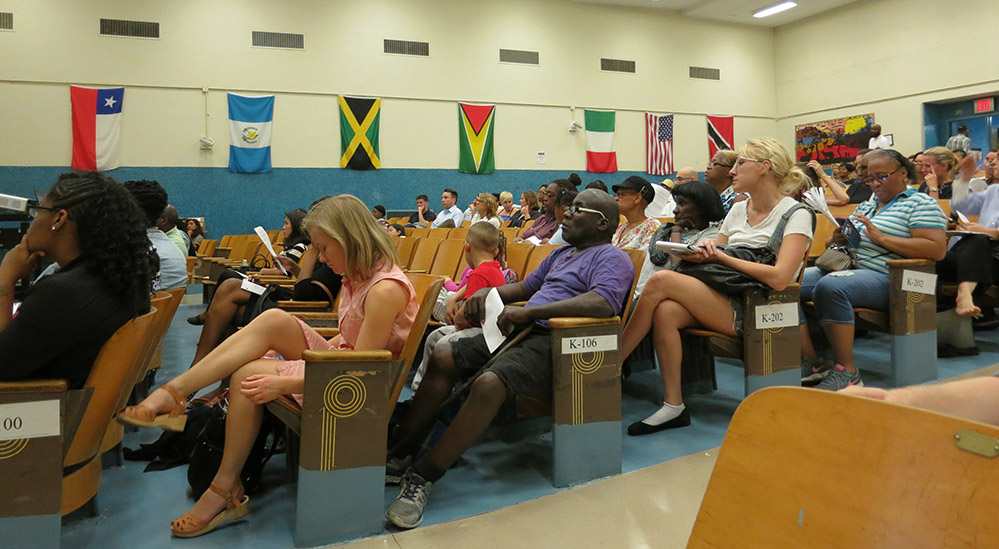
A heavily attended town hall meeting Wednesday about the proposed rezoning of P.S. 8 and P.S. 307 turned into an airing of general grievances in regards to gentrification. The meeting, held in the auditorium of P.S. 307, was attended predominantly by concerned parents from the two affected elementary schools, simultaneously representing two halves of a contrasting Brooklyn.
Brooklyn Heights’ P.S. 8 is overcrowded, and its student body is more than 50 percent white. The school’s zone, which includes Dumbo, is one of the largest in Brooklyn — perhaps a holdover from when Dumbo was not very residential. Vinegar Hill’s P.S. 307, which has one of the city’s smallest zones, has room to grow and services mainly black families, including from the Farragut Houses housing project across the street.
Intended as an informational session, the meeting was led by three officials from the Department of Education’s Office of District Planning, the Community Education Council of District 13, and the parent teacher association of P.S. 307.
A presentation by the suited DOE officials gave attendees an overview of the rezoning process, a rationale for this particular rezoning, and projected zone enrollment and demographic changes. The purpose of the rezoning is to alleviate overcrowding at P.S. 8, they said.
The proposal calls for P.S. 8 to decrease in size and 307 to increase; both schools are expected to have a lower percentage of minorities after the rezoning. For P.S. 8, this means going from a current 34 percent minority student body to a projected 25 to 35 percent minority student body. For P.S. 307, this means going from a current 95 percent minority student body to a projected 55 to 65 percent minority student body.
If enacted, the rezoning proposal will shrink P.S. 8’s zone boundaries and extend P.S. 307’s for a more equal division of the neighborhood. Currently pending approval by the CEC, proposed changes would be enacted for the 2016-2017 school year. Changes would affect only incoming pre-K, kindergarten, and new students.
Following the presentation, a question and answer session became heated, some parents remaining more levelheaded than others, and most expressing a larger dissatisfaction with the schooling system as a whole.
“You don’t have a lot of institutions in America where a majority white people want to function under black leadership,” Reverend Dr. Mark Taylor of nearby Church of the Open Door at 201 Gold Street asserted to thunderous applause. “All of our white brothers and sisters aren’t going to come down to the Farragut Houses and sing kumbaya.”
Such racial tensions were a theme of the night. Multiple commenters mentioned Brown vs. Board of Education, the segregation of New York’s schools, and the racial aspects of gentrification in the neighborhood.
Reverand Taylor called the rezoning proposal, “a P.S. 8 centric plan that leaves out 307.”
Shared concerns among commenters were the rapid implementation of the change and a perceived lack of sufficient notice given to zoned families in both school districts. As well, there was a shared frustration with the rapid development of luxury housing without an improvement in or construction of more local schools.
“You have space in those high rises — put students in ’em,” one P.S. 307 parent called out.
By the end of the meeting, it was clear parents felt they had not been involved in the process, that the rezoning should be delayed by at least a year, and that change and gentrification cause deep frustration and fear of the future.
Parents simultaneously declared a need for new schools while acknowledging their awareness that adequate spaces are available at institutions like P.S. 307. In this way, there was comprehension of the larger situation — Brooklyn’s current state of rapid change — yet no answers as to how to achieve what’s best for individuals and their respective communities.
“Ten years from now people will remember this decision that we make,” said Community Education Council member Horace Allison, “We’ve got to get all the communities moving in the same direction.”
There will be other another meeting regarding the rezoning at P.S. 8 this coming Monday, September 21, from 6:30 to 8 p.m.
Photos by Hannah Frishberg
Related Stories
School Rezoning to Assuage Overcrowding Surprises Dumbo and Vinegar Hill Parents
A Look at Four Recent Brooklyn Elementary School Rezonings
Two Town Hall Meetings Planned for Dumbo School Rezoning
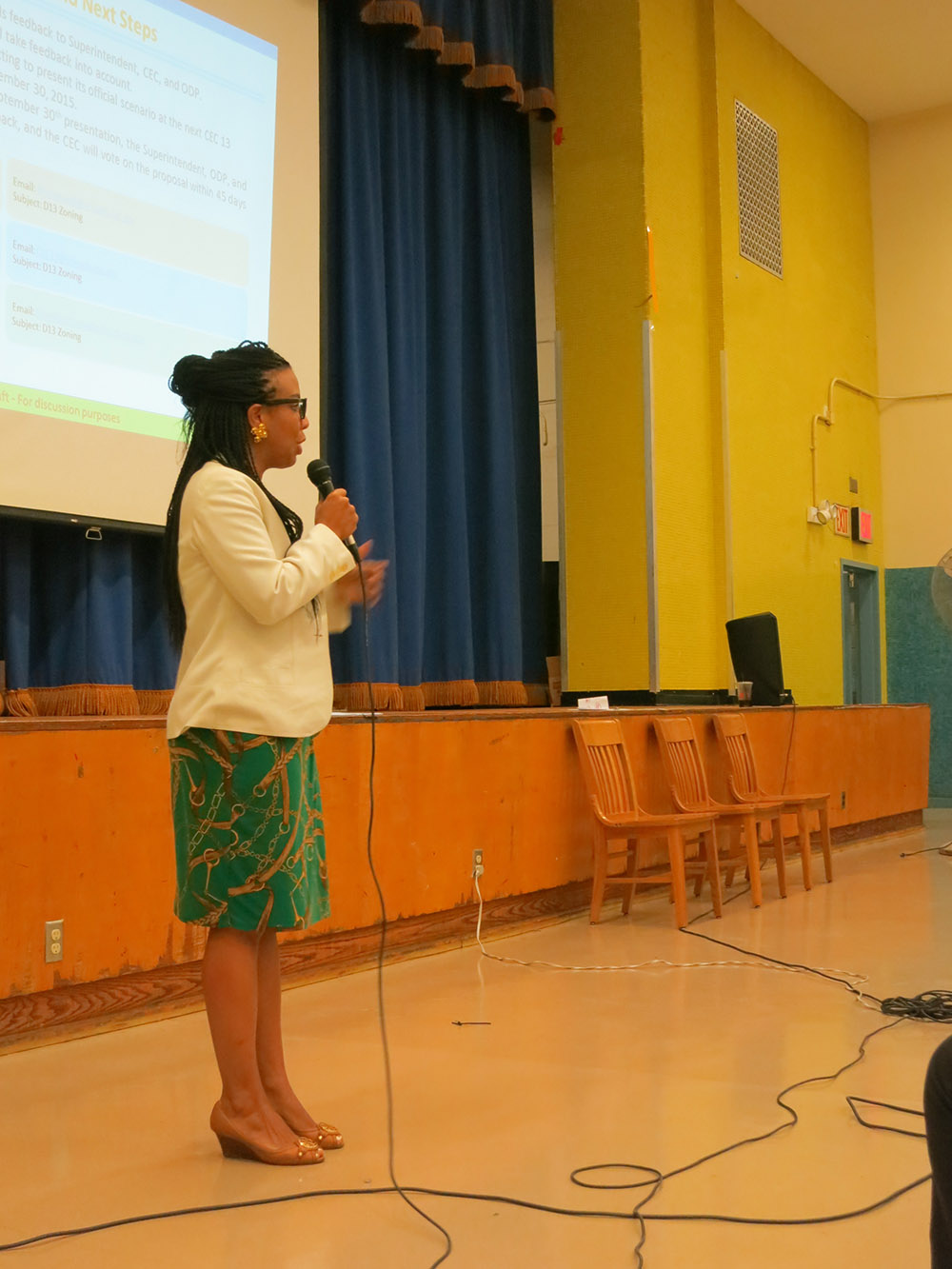 Council Member Laurie Cumbo
Council Member Laurie Cumbo
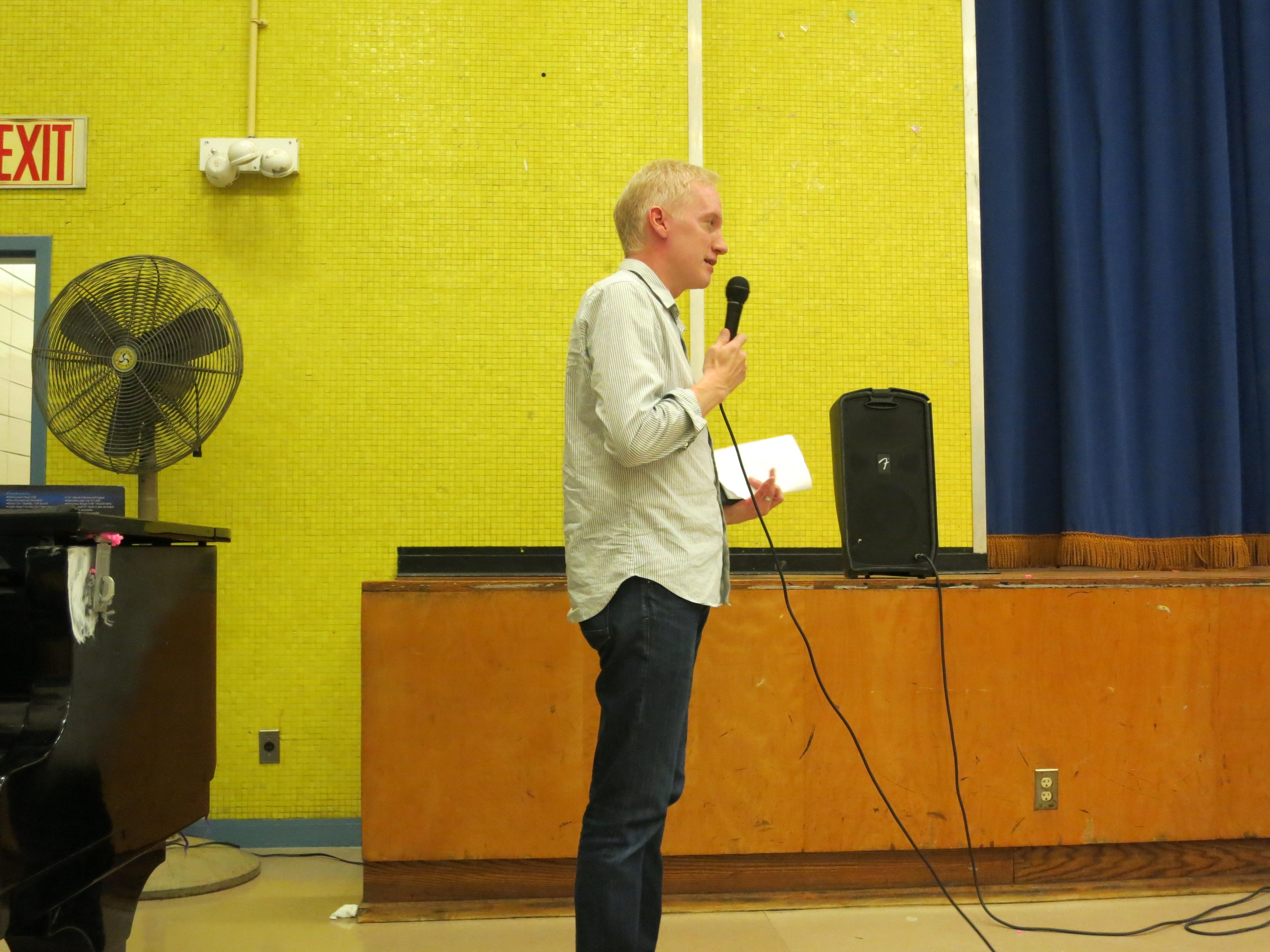
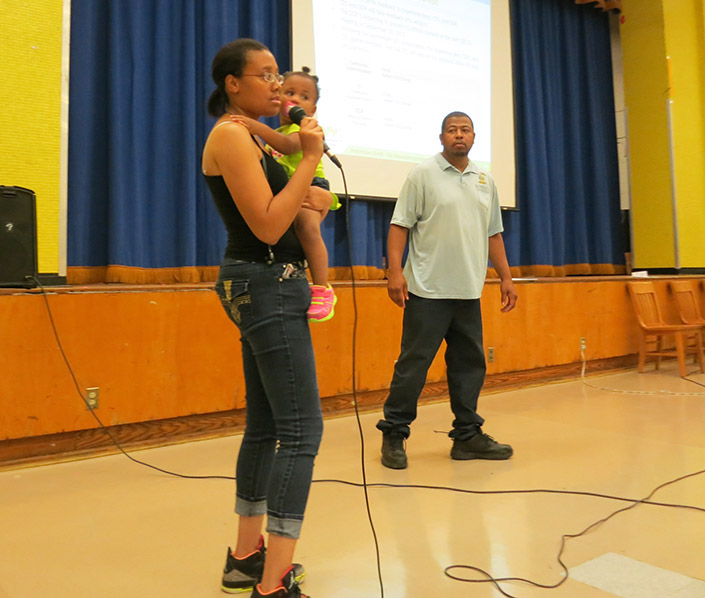

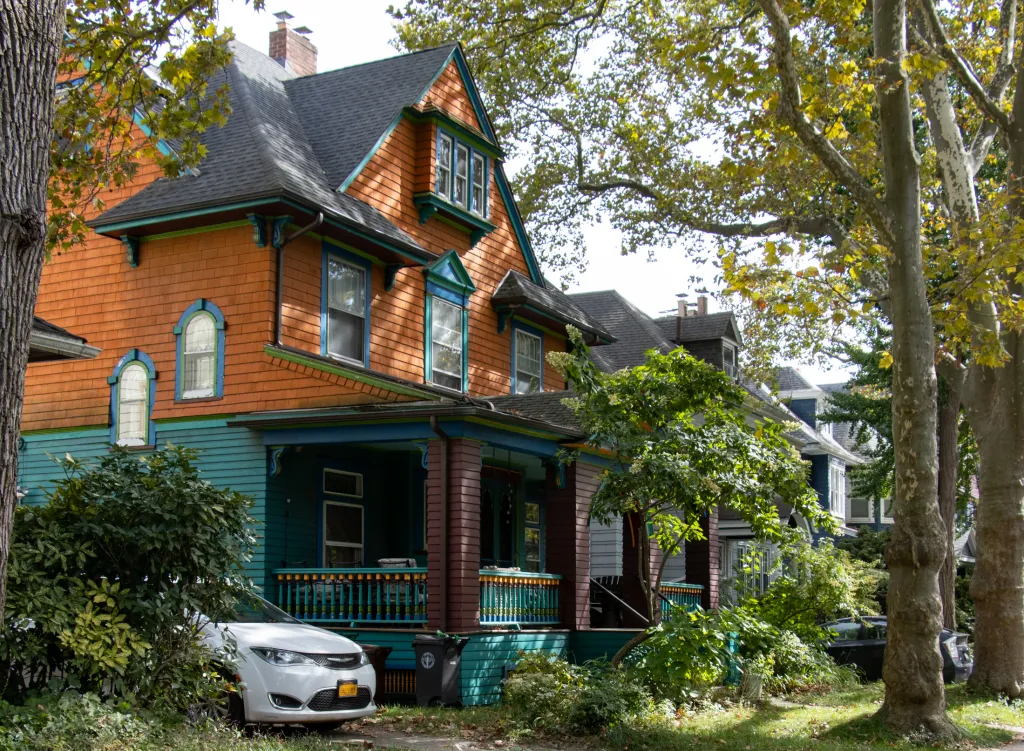
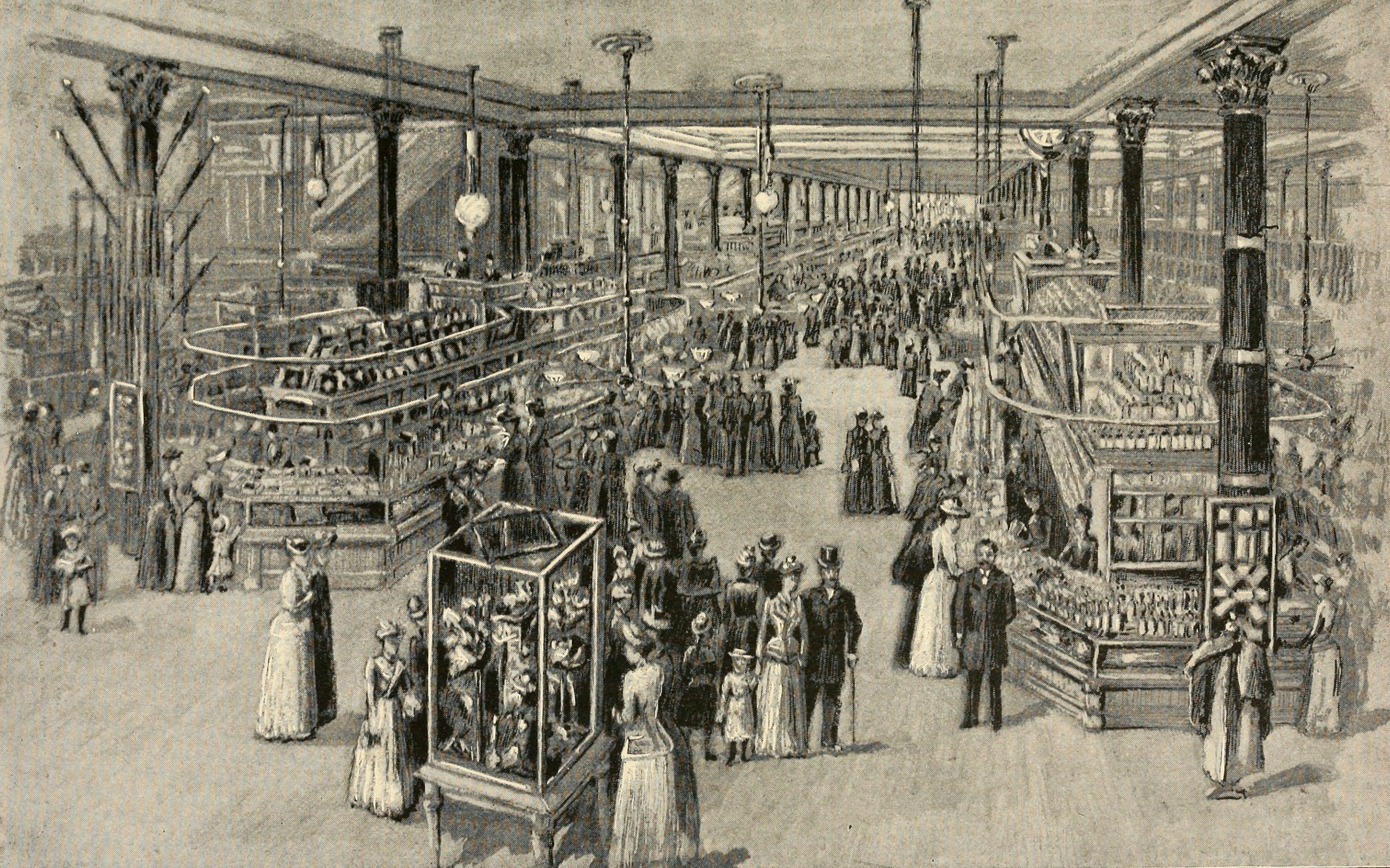
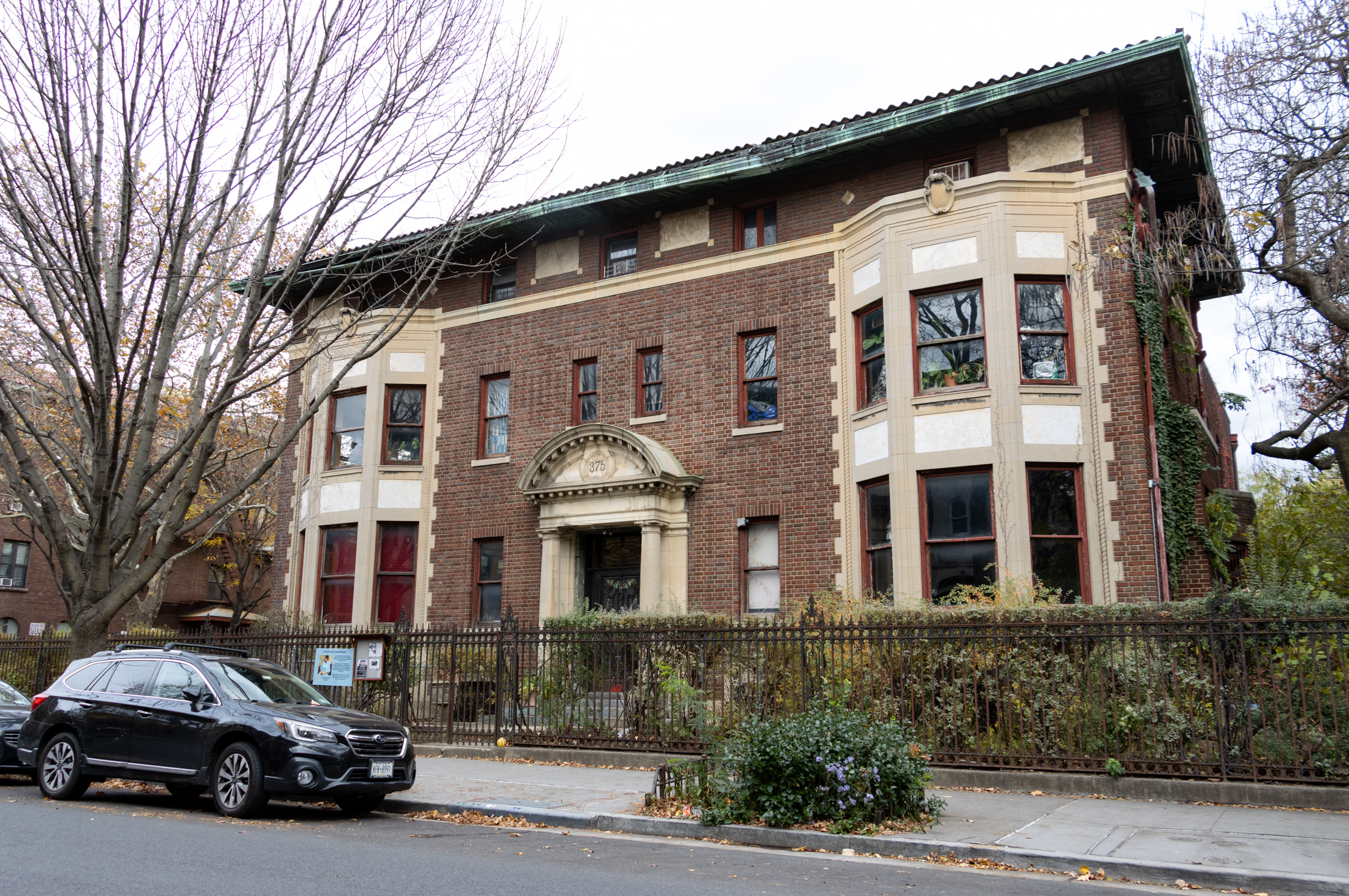
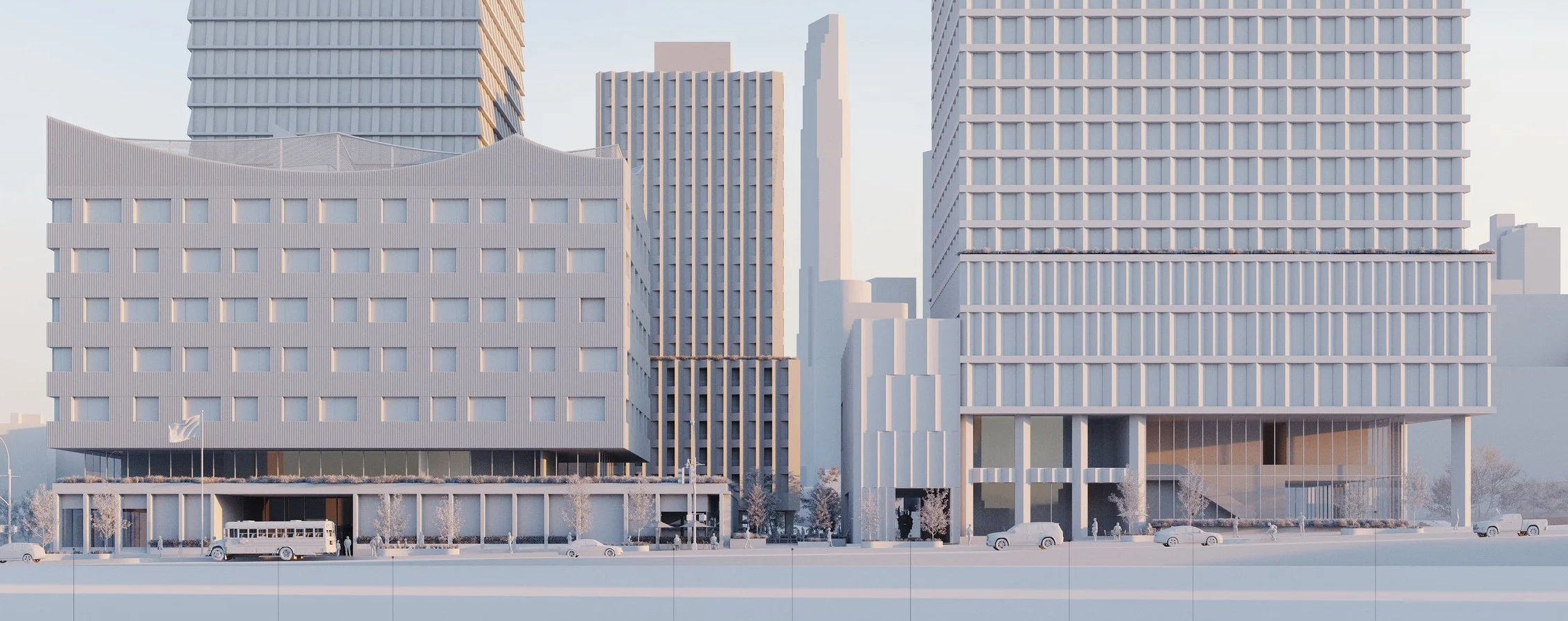
I was there, and this is a reasonably fair presentation, though I do think there was a little bit of a shift over the course of the meeting from a perspective that this shouldn’t happen or that this shouldn’t happen now, to some recognition that the zone lines need to change (for PS307 as well as PS8) and the question is how to manage the transition well. While I agree that integration — what we are basically talking about here — is hard and needs to be done mindfully so that all communities feel valued and respected, and no one is pushed out, and that time to work through conflicts as this moves forward is definitely needed, I do wish I was hearing more from people about how we start that work and not simply slowing the process down.
I lot of the comments here are about how relatively wealthy, white families won’t buy in — but a large chunk of this meeting (the real meat of the meeting) made clear that at least a part of the largely minority, less affluent community that either has children at PS307 and/or lives in the Farragut Houses doesn’t want the rezone either. People maybe say, of course the rezone needs to happen, the lines are clearly wrong and represent a lot of what’s wrong with our school system . . . but not yet, not this fast. And yet no one is talking about what exactly needs to happen to make the integration that would eventually follow work well (I don’t think it will in fact be a quick switch-over for a lot of the reasons people raise here). My sense was that people on all sides of this fear the change and they want to slow it down out of that fear — instead of engaging in concrete discussions about how to make something that is clearly needed for a host of reasons happen in a way that helps everyone. “We need more time” is not a path forward. I hope people start talking about what is needed to make this work and how to make it work — delay alone doesn’t help.
I was there, and this is a reasonably fair presentation, though I do think there was a little bit of a shift over the course of the meeting from a perspective that this shouldn’t happen or that this shouldn’t happen now, to some recognition that the zone lines need to change (for PS307 as well as PS8) and the question is how to manage the transition well. While I agree that integration — what we are basically talking about here — is hard and needs to be done mindfully so that all communities feel valued and respected, and no one is pushed out, and that time to work through conflicts as this moves forward is definitely needed, I do wish I was hearing more from people about how we start that work and not simply slowing the process down.
I lot of the comments here are about how relatively wealthy, white families won’t buy in — but a large chunk of this meeting (the real meat of the meeting) made clear that at least a part of the largely minority, less affluent community that either has children at PS307 and/or lives in the Farragut Houses doesn’t want the rezone either. People maybe say, of course the rezone needs to happen, the lines are clearly wrong and represent a lot of what’s wrong with our school system . . . but not yet, not this fast. And yet no one is talking about what exactly needs to happen to make the integration that would eventually follow work well (I don’t think it will in fact be a quick switch-over for a lot of the reasons people raise here). My sense was that people on all sides of this fear the change and they want to slow it down out of that fear — instead of engaging in concrete discussions about how to make something that is clearly needed for a host of reasons happen in a way that helps everyone. “We need more time” is not a path forward. I hope people start talking about what is needed to make this work and how to make it work — delay alone doesn’t help.
Folks who bought expensive condos in Dumbo are now upset that they’re kids are going to a lesser school. I can kinda understand that, but at the same time folks who bought recently really should’ve seen this coming.
What they fail to realize is that with this rezoning, PS307 will improve vastly and quickly. People forget that PS8 wasn’t a great school not that long ago. My kid just started pre-k at PS 307 and she loves it, the teacher is great. It’s mostly kids from the Houses, but so what…they’re all sweet kids and don’t see a difference.
Folks who bought expensive condos in Dumbo are now upset that they’re kids are going to a lesser school. I can kinda understand that, but at the same time folks who bought recently really should’ve seen this coming.
What they fail to realize is that with this rezoning, PS307 will improve vastly and quickly. People forget that PS8 wasn’t a great school not that long ago. My kid just started pre-k at PS 307 and she loves it, the teacher is great. It’s mostly kids from the Houses, but so what…they’re all sweet kids and don’t see a difference.
I can’t stress enough how important the school rezoning is for the future of Brooklyn.
When this country abandoned school integration, we basically abandoned the education of students of color. As it stands now, Brooklyn has the racial make-up to have an integrated system. Instead of embracing this opportunity, we have parents (mostly white) creating charters schools instead. But if we want to lift all students up and really have our children benefit from the borough’s diversity we have to integrate the system and stay committed to the course.
This American Life had a great story on this issue last month.
Listen if you get a chance: http://goo.gl/aHdmmR
I can’t stress enough how important the school rezoning is for the future of Brooklyn.
When this country abandoned school integration, we basically abandoned the education of students of color. As it stands now, Brooklyn has the racial make-up to have an integrated system. Instead of embracing this opportunity, we have parents (mostly white) creating charters schools instead. But if we want to lift all students up and really have our children benefit from the borough’s diversity we have to integrate the system and stay committed to the course.
This American Life had a great story on this issue last month.
Listen if you get a chance: http://goo.gl/aHdmmR
This is more a response to well_pHed below, but I couldn’t reply directly to that post for some reason. I think it’s right to say that it’s hard to untangle perceptions of leadership quality from issues of race and class, but even within D13 there are schools that still qualify for Title 1 money and are majority minority that do appeal, and apparently have growing appeal, to an increasingly diverse parent body. PS307 would be one of those — it’s got a tiny zone, so most students come from out of zone but many families have chosen that school because of perceptions (I would say, accurate ones) of strong leadership, good resources and programming; it is still has an overwhelmingly minority population and high free and reduced lunch numbers, but that is already shifting, regardless of a rezone. PS20 is probably another good example (with its French dual language program). PS133 too — but that is probably controversial, and it has a new building in addition to multiple dual language programs. I think we need to take issues of race and class seriously and understand how they play into perceptions of school quality; I also think we need understand what other factors play into perceptions of quality — because it does seem to be about more than simply race and class.
Great post Slopefarm. I agree that the charter movement outside of NYC is mostly a people of color movement. But in Brooklyn it has been used as a way to segregate the schools- especially in lower grades.
I don’t think the principals of schools with a majority children of color are doing all that well. The data shows that those schools are often given the least experience teachers and least effective principals. I think all parents have to hold these school accountable but the new parents have to include everyone in making the schools better. Otherwise, it becomes an us vs them. And no one likes to hear that their school is horrible- especially when the black and brown parents have been working hard with very little in terms of funding or help.
Great post Slopefarm. I agree that the charter movement outside of NYC is mostly a people of color movement. But in Brooklyn it has been used as a way to segregate the schools- especially in lower grades.
I don’t think the principals of schools with a majority children of color are doing all that well. The data shows that those schools are often given the least experience teachers and least effective principals. I think all parents have to hold these school accountable but the new parents have to include everyone in making the schools better. Otherwise, it becomes an us vs them. And no one likes to hear that their school is horrible- especially when the black and brown parents have been working hard with very little in terms of funding or help.